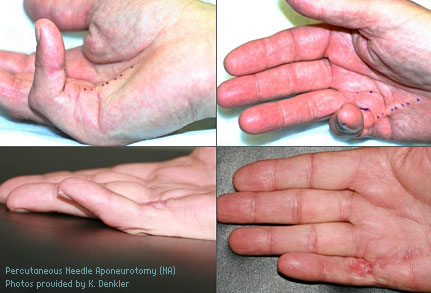Advances in Dupuytren’s Disease and the nodules and restrictive contractures of the fingers that can result have lead to a new minimally invasive procedure known today as Percutaneous Needle Aponeurotomy (NA), also known as Percutaneous Needle Fasciotomy (PNF).
Unlike traditional surgery, which entailed the open surgical excision of scarred tissue and obtrusive nodules affecting the function of the fingers and hand, a percutaneous needle aponeurotomy is a “minimally invasive surgical procedure” out patient procedure utilizing a local anesthetic and “needles” to puncture the contracting cords or tissue caused by the disease.

This puncturing weakens the cord and prompts a break down, which frees the fingers and allows more normal function of the hand.
First introduced in Europe by a French physician, the needle aponeurotomy has become available in some US cities and is increasingly proving to yield excellent results.
While patients undergo a rehabilitation program to ensure full resumption of hand function, the minimally invasive nature of the procedure allows a faster recovery and more rapid return to activity. The risks of traditional open surgery are reduced and patients report minimal pain following the procedure.
